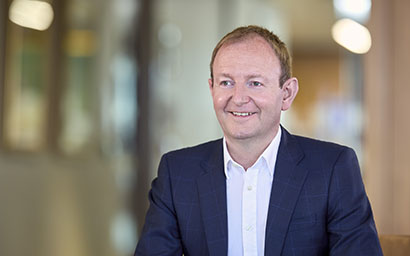Getting greener all the time, Aviva Investors is poised to disinvest from certain coal-related companies. Yet CEO Mark Versey still has room for ‘brown’ investing, he tells Nick Fitzpatrick.
Companies generating more than 5% of revenue from thermal coal have until the end of this year to commit to science-based ‘net-zero’ targets before Aviva Investors’ patience runs out. At that point, the asset manager – owned by the UK’s largest life insurance company, Aviva – will divest from them.
The stance complements the January 2021 Climate Engagement Escalation Programme in which Aviva Investors intensified shareholder engagement over climate change with the largest ‘Scope 3 emitters’ across oil and gas, mining and utilities. (Scope 3 covers emissions from operations produced by, for example, a supplier in a reporting company’s supply chain.) That same month, Mark Versey became the asset manager’s CEO.
“We went to these companies a year ago and said that we would divest in three years if they did not sign up to net zero. The oil and gas sector is halfway there. Fifty per cent are lagging, 50% are not,” Versey tells Funds Europe. Other industrial sectors will be targeted in future. For now, the escalation programme focuses on 30 “systematically important carbon emitters”.
Two months after the firm introduced the escalation programme, parent company Aviva became the first major insurer worldwide to commit to a net-zero carbon emissions target by 2040, a stance that Versey describes as one of the most ambitious globally. It entails a cut of 25% in the carbon intensity of its investments by 2025 and of 60% by 2030. This is ahead of the 50% cut required by the Paris Agreement that countries adopted after COP21 in 2015.
The insurer also aims for net zero carbon emissions from its own operations and supply chain by 2030.
“Strategy miss”
Versey joined Aviva Investors in 2014 and, prior to being CEO, was its chief investment officer for real assets. From the outset, he wanted the firm – which has £253 billion (€286 billion) of assets under management – to become recognised chiefly as a sustainable investor: “When I became CEO, I wanted to think about what it was that Aviva Investors should stand for, and it was sustainable investing. I was massively impressed at our ESG capability.”
He says its ESG pedigree is “one of the best”, having helped to word the UN Principles for Responsible Investment. But, he adds: “What we did not have was a product explicitly focused or so advanced on this. It was a strategy miss for us.”
“We went to these companies a year ago and said that we would divest in three years if they did not sign up to net zero. the oil and gas sector is halfway there. fifty percent are lagging, 50% are not.”
Before ESG, the firm had strong links with another abbreviation. Go back a few years, and the name Aviva Investors was virtually synonymous with AIMS – an absolute return product that raised huge sums of money. Absolute return investing – a hedge fund-like strategy that allowed active managers to compete with passive ETFs for market share – was a major force in asset management, and AIMS was one of the largest of these funds.
Aviva Investors started to cut a path towards ESG under Euan Munro, the former CEO who is strongly accredited with spreading absolute return investing among retail investors and intermediaries.
The path towards sustainable investing includes the firm sharing responsibility for ESG issues between its ESG department and investment desks, with voting done through the specialist knowledge of its ESG team. Policy decisions, and practical application of how it votes, are made in consultation with investment teams.
Are green yields “truly additive”?
Versey, however, has become quite well known for almost championing ‘brown’ investing over green. For example, last year was a record year for green bonds. The market more than doubled to $572 billion (€587 billion), according to a study commissioned by law firm Linklaters. Aviva, the insurer, has committed to investing £6 billion in green assets by 2025, and Aviva Investors has already delivered £1 billion of loans focused on climate transition in the real estate sector.
The asset manager does invest in green bonds – but Versey says investors must question whether green bonds are “truly additive” to a portfolio.
 “Some funds may have restrictions that mean they can only invest in bonds that fund tangible climate solutions and so they cannot buy ‘brown’ bonds. But a question for many portfolios is ‘when should I buy green over brown?’”
“Some funds may have restrictions that mean they can only invest in bonds that fund tangible climate solutions and so they cannot buy ‘brown’ bonds. But a question for many portfolios is ‘when should I buy green over brown?’”
By way of example, he highlights that a car maker might factor spending on hydrogen research into its business plan and that a green bond could be used to raise funds for the project. The bond, therefore, has a tangible result. Yet an automaker that is serious about hydrogen research will find a way to fund this. The bond needn’t be green.
“Is it really additive to issue a green bond to support hydrogen research if hydrogen research is already in the business plan? Should we not buy a ‘brown’ bond and get higher yield for the same level of corporate risk?
“Brown bonds have higher yields, and this obviously incentivises corporates to issue green bonds.”
Versey adds that, eventually, all bonds will be green as corporates sign up to net zero.
Data “improving”
One of Aviva Investor’s largest clients is Aviva the insurer, for whom bond investments are critically important. European solvency rules for insurers have pushed insurers to hold more fixed-income investments in order to manage liabilities. The main asset classes for Aviva are corporate bonds, equities, direct real estate and sovereign debt. The insurer has developed an ESG methodology for sovereign debt. Just as Aviva Investors has a proprietary methodology for assessing corporate issuers against their ESG practices, it has developed a parallel tool to rate and score sovereigns, too.
Versey says: “For some asset classes like government bonds, there are not any agreed methodologies for forward-looking projections. For example, how do we assess whether countries which have made net-zero commitments have a credible transition roadmap to actually get them there?”
Any asset manager with a sustainability agenda faces challenges with data. Versey highlighted the difficulties at a CEO panel for the European Fund and Asset Management Association last year.
“Private markets have become more mainstream because institutional investors are now much more educated and understand that, although there is illiquidity, there is also a chance to make higher returns.”
Data is improving, he says now, albeit there are still multiple data sources that lack consistency, meaning common standards are still needed, he adds. “A lot of data is backwards-looking and while that is important for being able to hold corporates to account, investment decisions are forward-looking.”
Despite this flaw, he says data can still signal specific issues to engage organisations over. This applies not just to companies but to real estate.
“For example, in real estate and corporates, we could spot ideas that may become trends in the move from ‘brown’ to ‘green’, which could be a very good source of return. Data signals areas of focus that create opportunities to engage a corporate with and make it become greener.”
Neatly packaged morals
In ‘50 Shades of Green’, an article written by Versey and published on the firm’s website, he calls for there to be a more sophisticated conversation about ESG that takes into account ESG’s many nuances.
“In reality, ESG cannot be reduced to simple binary arguments. It encompasses such a wide array of meanings and activities that to try and do so is foolhardy,” he writes.
Such incoherency includes where tech companies dominate environmental indices – but some may score poorly on social issues, such as tax transparency. There is also the difficult issue of the net-zero transition being ‘just’: in other words, having limited impact on jobs and communities relating to industries – such as coal – that are most affected.
“Corporates might make a good case about how the transition may damage their industry if they move too fast. We need corporates to improve biodiversity, but we want them to do it without having a social impact,” says Versey. “There needs to be a robust debate over net zero’s impact on jobs.”
He adds: “ESG is not black and white but horribly, horribly grey.”
Focus on growth
The firm saw £0.2 billion of inflows in the second quarter of the year, making up for the same amount in outflows in Q1 at a time of volatile markets. This compares to the £1.1 billion net inflows in the first half of last year.
As an abbreviation, AIMS is not erased. Saying that he is now focused on growth, Versey says Aviva Investors still stands for multi-asset investing. The strategy offers a low-cost multi-asset selection for corporate DC pension schemes and wealth managers.
When Versey took over as CEO, he closed areas that were not in demand or where the firm could not compete well, he tells Funds Europe. Certain equity offerings, domestic US corporate bonds, and some real estate funds fell in scope.
Versey highlights the firm’s real assets business, where he was once CIO. The business has about £50 billion of assets under management. “Our scale is really hard to replicate,” he says.
“Private markets have become more mainstream because institutional investors are now much more educated and understand that, although there is illiquidity, there is also a chance to make higher returns.”
 But illiquidity is still a problem for the retail market. Extending this asset class to retail investors – which is a growing topic of conversation within the private equity world – is something that Versey appears to take seriously, potentially leveraging the help of the ‘LTAF’.
But illiquidity is still a problem for the retail market. Extending this asset class to retail investors – which is a growing topic of conversation within the private equity world – is something that Versey appears to take seriously, potentially leveraging the help of the ‘LTAF’.
This ‘Long-term Asset Fund’ is a new (since November 2021) regulated fund structure in the UK, similar in idea to the European Long-term Investment Fund. The plan is that LTAFs will house illiquid assets for investors who include retail individuals, broadening the reach of illiquid assets to a wider audience.
Versey acknowledges that the “hardest area of the market is the retail and advice-led area, because a lot of the platforms and the regulation require daily price liquidity.”
At the onset of the Covid pandemic, Aviva Investors was one of a number of fund managers that suspended dealing in property funds. Outflows triggered the suspensions. In its case, Aviva Investors said suspensions were to give fairer treatment to a wider number of investors.
“To have daily liquidity, a fund needs to have large cash holdings. As a fund gets smaller, the cash proportion needs to increase to maintain liquidity and eventually, there is a drag on performance. Closing the fund is the right thing to do – but the issue was possibly people were not expecting it. That is why we need the LTAF.
“It is a feature of the asset class that you can invest all the proceeds and invest in more real estate or private equity, and where lock-in periods are more in a long-term saver’s interests. This is where the LTAF structure might help. Getting it right opens the door for institutional investors, including corporate DC schemes, to make the most of investment opportunities in infrastructure, energy and real estate, which can drive long-term performance whilst also doing good from a societal perspective.”
He adds: “Time will tell if consumers buy it [the LTAF]. For now, most accounts will be through pension or multi-asset funds.”
© 2022 funds europe





